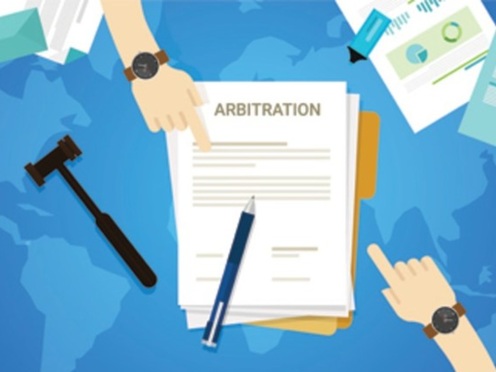Recent Developments in the Application of Equitable Estoppel to Compel Arbitration
Practitioners seeking to avoid having their clients forced into arbitration by a nonsignatory should examine carefully the relevant arbitration clause and consider the proper forum in which to file suit.
May 17, 2019 at 01:30 PM
8 minute read
 To permit a party that is not a signatory to an arbitration agreement (a “nonsignatory”) to compel arbitration against a signatory has always been controversial in light of the U.S. Supreme Court's longstanding precedent that arbitration is purely “a matter of consent, not coercion,” and that “[t]he FAA … does not require parties to arbitrate when they have not agreed to do so.” Volt Info. Scis. v. Bd. of Trs., 489 U.S. 468, 478 (1989). Despite this precedent, the doctrine of “equitable estoppel” has been applied to enable a nonsignatory to arbitrate in the absence of express consent. Carroll v. LeBoeuf, Lamb, Greene & MaCrae, 374 F. Supp. 2d 375, 378 (S.D.N.Y. 2005) (“[t]he doctrine … depend[s] upon … considerations of adjudicative economy, not consent”). At its most general level, the doctrine permits a nonsignatory to force a signatory to arbitrate when the issues in dispute relate to a signatory's contract with another party that contains an arbitration clause. Some courts have criticized the doctrine as nothing more than a docket-clearing device. Other courts have found the doctrine essential to ensure that signatories do not circumvent their agreements to arbitrate through procedural gamesmanship (that is, suing related parties and agents who are not signatories but who should nevertheless benefit from the arbitration agreement).
To permit a party that is not a signatory to an arbitration agreement (a “nonsignatory”) to compel arbitration against a signatory has always been controversial in light of the U.S. Supreme Court's longstanding precedent that arbitration is purely “a matter of consent, not coercion,” and that “[t]he FAA … does not require parties to arbitrate when they have not agreed to do so.” Volt Info. Scis. v. Bd. of Trs., 489 U.S. 468, 478 (1989). Despite this precedent, the doctrine of “equitable estoppel” has been applied to enable a nonsignatory to arbitrate in the absence of express consent. Carroll v. LeBoeuf, Lamb, Greene & MaCrae, 374 F. Supp. 2d 375, 378 (S.D.N.Y. 2005) (“[t]he doctrine … depend[s] upon … considerations of adjudicative economy, not consent”). At its most general level, the doctrine permits a nonsignatory to force a signatory to arbitrate when the issues in dispute relate to a signatory's contract with another party that contains an arbitration clause. Some courts have criticized the doctrine as nothing more than a docket-clearing device. Other courts have found the doctrine essential to ensure that signatories do not circumvent their agreements to arbitrate through procedural gamesmanship (that is, suing related parties and agents who are not signatories but who should nevertheless benefit from the arbitration agreement).
The equitable estoppel doctrine is thought to have originated in Hughes Masonry Company v. Greater Clark County School Building, 659 F.2d 836 (7th Cir. 1981), in which the court held that a contractor was “equitably estopped” from denying arbitration against an owner's construction manager, where the agreement between the contractor and owner specifically identified the construction manager as the entity that would “perform on behalf of the owner.” There was no “estoppel” in the traditional sense (estoppel usually requires some form of detrimental reliance), but the court invoked the “estoppel” mantra to conclude that the contractor could not “repudiate[e]” the arbitration provision of its agreement with the owner. Over time, courts have expanded the doctrine significantly, making it possible for any defendant in a multi-defendant fraud case to latch on to another defendant's arbitration agreement, in a game of connect-the-dots. See, e.g., Camferdam v. Ernst & Young Intern., 2004 WL 307292 (S.D.N.Y. Feb. 13, 2004).
The Second Circuit appears to have first adopted the doctrine in Smith/Enron Cogeneration Limited Partnership v. Smith Cogeneration International, 198 F.3d 88 (2d Cir. 1999), declaring it a matter of federal common law. Although the Circuit has at times expressed reservations about the doctrine, it routinely affirms district court orders sending cases brought against nonsignatories to arbitration on the basis of equitable estoppel. Compare Ross v. Am. Express Co., 547 F.3d 137, 148 (2d Cir. 2008) (acknowledging that the doctrine was “problematic because arbitration is of course a matter of contract”) with Birmingham Assocs., Ltd. v. Abbott Labs., 328 Fed. Appx. 42 (2d Cir. 2009). The Circuit has struggled at times to justify the doctrine in light of the Supreme Court's focus on consent, suggesting that the doctrine is “really based on an agreement implied in fact” which “extend[s] the contours” of consent. Sokol Holdings v. BMB Munai, 542 F.3d 354, 361-62 (2d Cir. 2008). That rationale, however, seems at odds with the proposition that courts cannot “infer consent when it comes to … fundamental arbitration questions,” and there is no question more fundamental than whether parties have agreed to arbitrate. Lamps Plus v. Varela, 2019 WL 1780275, at *1 (U.S. April 24, 2019).
The U.S. Supreme Court has issued several decisions impacting the doctrine's application. In Arthur Andersen v. Carlisle, 556 U.S. 624 (2009), the court held that state, not federal, law must be applied to determine whether nonsignatories can compel arbitration. Practically every federal court (including the Second Circuit) had assumed it was a matter of federal law. Following Carlisle, several federal courts expressly abrogated their pre-2009 precedent. See, e.g., Lawson v. Life of the South Ins. Co., 648 F.3d 1166, 1171 (11th Cir. 2011). The Seventh Circuit did so just last year, and, in the process, practically eliminated the doctrine under Illinois law, which the court held required a showing of detrimental reliance. Warclak v. Subway Rests., 880 F.3d 870 (7th Cir. 2018).
In another case, American Express Company v. Italian Colors Restaurant, 570 U.S. 228 (2013), the Court reaffirmed that “courts must 'rigorously enforce' arbitration agreements according to their terms … including terms that 'specify with whom the parties choose to arbitrate their disputes.'” Id. at 233 (quoting Stolt-Nielsen S.A. v. AnimalFeeds Int'l, 559 U.S. 662, 638 (2010)). That is, parties can define not only the issues they will arbitrate and the rules of arbitration, but they can also circumscribe who will be able to invoke the arbitration agreement. Virtually every arbitration agreement limits to the contracting parties the right to demand arbitration.
Carlisle and Italian Colors raise important questions about how courts ought to apply equitable estoppel. Following Carlisle, some district courts in New York have applied state law. See, e.g., Laumann v. Nat'l Hockey League, 989 F. Supp. 2d 329, 339-40 (S.D.N.Y. 2013). Other district courts, however, continue to rely exclusively on federal law. See, e.g., Reyes v. Gracefully, 2018 WL 2209486 (S.D.N.Y. May 11, 2018). Such inconsistent application may have significant consequences for litigants, since it is unclear whether the doctrine is even recognized under New York law. The Court of Appeals has never adopted it, and the First Department has questioned whether it exists. Rosenbach v. Diversified Grp., 39 A.D.2d 271 (1st Dep't 2007). Intent is paramount under New York law, and without it arbitration will ordinarily be denied. See, e.g., Warner v. U.S. Sec. & Futures, 685 N.Y.S.2d 25, 26 (1st Dep't 1999) (nonsignatory could not compel arbitration because there must be “evidence affirmatively establishing that the parties expressly agreed to arbitrate their disputes”). Where New York trial courts have applied the doctrine, they have applied federal law, which no longer applies under Carlisle. See, e.g., Conwill v. Arthur Andersen, 12 Misc.2d 1171(A) (Sup. Ct. N.Y. Co. 2006) (applying “substantive federal law”). Whether the Court of Appeals will ultimately accept some form of equitable estoppel remains to be seen.
In addition, federal courts in New York have not resolved whether Italian Colors restricts the doctrine where (as is almost always the case) the arbitration agreement expressly limits arbitration to the contracting parties. The few courts that have addressed this question have reached sharply different conclusions. In Bankers Conseco Life Insurance Company v. Feuer, 2018 WL 1353279 (S.D.N.Y. March 15, 2018), the court concluded that Italian Colors was irrelevant on the basis that it was limited to class arbitration. Id. at *6-7. Yet in Norcast, S.A.R.L. v. Castle Harlan, 2014 WL 43492 (S.D.N.Y. Jan. 6, 2014), the court refused to allow a nonsignatory parent company to invoke the doctrine, even though the plaintiff was suing it for making misrepresentations in connection with the plaintiff's purchase of the parent's subsidiary. Id. at *8-9. Application of the doctrine to those facts would undoubtedly have been allowed under traditional Second Circuit precedent. But the arbitration clause was limited to “any dispute, controversy or claim between any Parties hereto” and “Parties” was defined as only the plaintiff and the subsidiary. Id. at *2. Relying on Italian Colors, the court refused to compel arbitration, noting that courts should not “'reach a result inconsistent with the plain text of the contract, simply because the policy favoring arbitration is implicated.'” Id. at *4 (quoting E.E.O.C. v. Waffle House, 534 U.S. 279, 294 (2002)). See also Republic of Iraq v. BNP Paribas USA, 472 Fed. Appx. 11, 13-14 (2d Cir. 2012) (the parties' “express identification of Parties as the only persons who could refer disputes to arbitration” meant that the nonsignatory could not compel arbitration).
While a few federal courts in New York have interpreted Italian Colors' focus on consent and Carlisle's incorporation of state law as limitations on nonsignatories' ability to compel arbitration, there is no consensus on these issues. The Second Circuit will hopefully be presented with an opportunity to eliminate confusion by abrogating its pre-Carlisle precedent, requiring district courts to apply state law, defining (until the Court of Appeals does) what New York law is, and determining whether Italian Colors constrains the ability of courts to compel signatories to arbitrate with nonsignatories.
Until then, practitioners seeking to avoid having their clients forced into arbitration by a nonsignatory should examine carefully the relevant arbitration clause and consider the proper forum in which to file suit. It is advisable to survey the law of the available jurisdictions to determine where the doctrine is viable and whether federal courts apply state or federal law. Similarly, practitioners should consider whether other jurisdictions have applied Italian Colors to deny arbitration where the arbitration clause is limited to disputes between the contracting parties.
Adam J. Kaiser is a partner and Jenna Polivy is a senior associate at Alston & Bird.
This content has been archived. It is available through our partners, LexisNexis® and Bloomberg Law.
To view this content, please continue to their sites.
Not a Lexis Subscriber?
Subscribe Now
Not a Bloomberg Law Subscriber?
Subscribe Now
NOT FOR REPRINT
© 2025 ALM Global, LLC, All Rights Reserved. Request academic re-use from www.copyright.com. All other uses, submit a request to [email protected]. For more information visit Asset & Logo Licensing.
You Might Like
View All


Trending Stories
- 1Troutman Pepper, Claiming Ex-Associate's Firing Was Performance Related, Seeks Summary Judgment in Discrimination Suit
- 2Law Firm Fails to Get Punitive Damages From Ex-Client
- 3Over 700 Residents Near 2023 Derailment Sue Norfolk for More Damages
- 4Decision of the Day: Judge Sanctions Attorney for 'Frivolously' Claiming All Nine Personal Injury Categories in Motor Vehicle Case
- 5Second Judge Blocks Trump Federal Funding Freeze
Who Got The Work
J. Brugh Lower of Gibbons has entered an appearance for industrial equipment supplier Devco Corporation in a pending trademark infringement lawsuit. The suit, accusing the defendant of selling knock-off Graco products, was filed Dec. 18 in New Jersey District Court by Rivkin Radler on behalf of Graco Inc. and Graco Minnesota. The case, assigned to U.S. District Judge Zahid N. Quraishi, is 3:24-cv-11294, Graco Inc. et al v. Devco Corporation.
Who Got The Work
Rebecca Maller-Stein and Kent A. Yalowitz of Arnold & Porter Kaye Scholer have entered their appearances for Hanaco Venture Capital and its executives, Lior Prosor and David Frankel, in a pending securities lawsuit. The action, filed on Dec. 24 in New York Southern District Court by Zell, Aron & Co. on behalf of Goldeneye Advisors, accuses the defendants of negligently and fraudulently managing the plaintiff's $1 million investment. The case, assigned to U.S. District Judge Vernon S. Broderick, is 1:24-cv-09918, Goldeneye Advisors, LLC v. Hanaco Venture Capital, Ltd. et al.
Who Got The Work
Attorneys from A&O Shearman has stepped in as defense counsel for Toronto-Dominion Bank and other defendants in a pending securities class action. The suit, filed Dec. 11 in New York Southern District Court by Bleichmar Fonti & Auld, accuses the defendants of concealing the bank's 'pervasive' deficiencies in regards to its compliance with the Bank Secrecy Act and the quality of its anti-money laundering controls. The case, assigned to U.S. District Judge Arun Subramanian, is 1:24-cv-09445, Gonzalez v. The Toronto-Dominion Bank et al.
Who Got The Work
Crown Castle International, a Pennsylvania company providing shared communications infrastructure, has turned to Luke D. Wolf of Gordon Rees Scully Mansukhani to fend off a pending breach-of-contract lawsuit. The court action, filed Nov. 25 in Michigan Eastern District Court by Hooper Hathaway PC on behalf of The Town Residences LLC, accuses Crown Castle of failing to transfer approximately $30,000 in utility payments from T-Mobile in breach of a roof-top lease and assignment agreement. The case, assigned to U.S. District Judge Susan K. Declercq, is 2:24-cv-13131, The Town Residences LLC v. T-Mobile US, Inc. et al.
Who Got The Work
Wilfred P. Coronato and Daniel M. Schwartz of McCarter & English have stepped in as defense counsel to Electrolux Home Products Inc. in a pending product liability lawsuit. The court action, filed Nov. 26 in New York Eastern District Court by Poulos Lopiccolo PC and Nagel Rice LLP on behalf of David Stern, alleges that the defendant's refrigerators’ drawers and shelving repeatedly break and fall apart within months after purchase. The case, assigned to U.S. District Judge Joan M. Azrack, is 2:24-cv-08204, Stern v. Electrolux Home Products, Inc.
Featured Firms
Law Offices of Gary Martin Hays & Associates, P.C.
(470) 294-1674
Law Offices of Mark E. Salomone
(857) 444-6468
Smith & Hassler
(713) 739-1250







